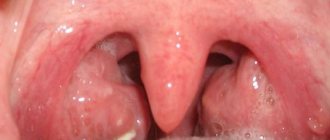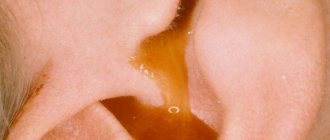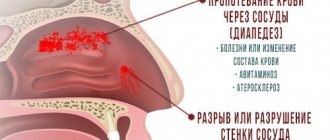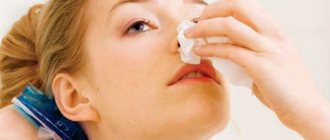16 Health • Children's health 10/03/2016
Dear readers, today we will talk about what to do when a child has ear pain. If this happens on an ordinary day, then, of course, any wise parent will go with the child to the clinic or call a doctor at home.
But what if the pain overtook you on a weekend, at night, or at this time you are far from home? An adult can endure it until the morning, but ear pain in a child is a special case! Prolonged suffering will cause trauma to the baby’s delicate psyche, and timely assistance not provided can cause the disease to worsen. Every parent should know how to provide first aid to their baby without causing harm.
Today on the blog I want to present you an article by otorhinolaryngologist Svetlana Ershova. You are already familiar with it from the article Ear Hurts. What to do at home. Svetlana has to work with both adults and children, and today she will tell us how to provide first aid if a child’s ear pain takes you by surprise.
Good day, dear readers of Irina’s blog. If you or your loved ones have small children, then pay attention to the information presented in this article. At the first complaint of ear pain in a child, you need to make an appointment with an otolaryngologist. Only an ENT doctor (not a pediatrician!) using special instruments can examine the eardrum, make a diagnosis and prescribe the correct treatment.
But there is no need to panic if you find yourself far from civilization and your child complains of ear pain. You yourself can help your baby if you know the basic rules of first aid.
In my opinion, the main commandment of a doctor is “Do no harm!” should become a commandment for every parent. You should know the main points when self-medication can harm your baby, and avoid them.
Causes of ear pain in children
The structure of a child's ear is somewhat different from that of an adult. Due to the underdevelopment of the cartilage, the auditory (also known as Eustachian) tube in children exits directly into the nasopharynx. Therefore, as soon as the baby begins to have a runny nose, there is a high risk of mucus flowing into the auditory tube and, as a result, the development of otitis media.
To avoid this, you need to prevent the occurrence of colds whenever possible. And if a runny nose continues for more than three days, then be sure to show the child to an otolaryngologist.
Attention! Treat your child’s runny nose in a timely manner and then you will forget about otitis media forever.
To understand how to provide first aid to your baby, you need to know what caused this problem. Ear pain in a child can occur for the following reasons.
- Getting a foreign body or insect into the ear;
- Trauma (barotrauma, fall from a height, damage to the ear canal with a sharp object);
- Water getting into the ear;
- Otitis (inflammation of the ear canal and eardrum);
- Eustacheitis (inflammation of the Eustachian tube);
- Infectious diseases;
- The first signs of a cold (ARVI);
- Sulfur plugs;
- Hypothermia.
Preventive measures
Recommendations:
- timely treatment of colds, nasopharyngeal diseases, fight against caries. Do not allow the acute phase of viral, fungal or bacterial infections to become chronic;
- strengthening the immune system, walks in the air, nutrition rich in vitamins, hardening;
- Clean your ears regularly, but don't overdo it. You should not rub the ear canal for a long time, with pressure: you yourself will provoke tissue irritation and further inflammation. Clean the outer part of the ear, do not push the cotton swabs far inside;
- In windy, cold weather, be sure to wear a cap or hat appropriate for the weather. Make sure the kids don't freeze.
What to do if your child has an earache? Useful tips in the following video:
How to provide first aid to a child with ear pain?
Parents often cannot determine why their baby has ear pain, so to provide first aid for ear pain, you need to use only those methods that will not harm the little body.
Nasal drops and painkillers
If you complain of pain in the ear, you need to drip vasoconstrictor drops into your nose and give any painkiller that is in your first aid kit. If your baby is allergic, you can give him an antiallergic drug prescribed by his attending allergist.
If an insect gets into your child's ear
If an insect gets into the ear, it does not pose any danger to a healthy ear, much less to the eardrum. But a fly or cockroach can move its legs and touch the eardrum, causing severe pain and dizziness. To alleviate the baby's suffering, you can drip warm oil or alcohol-based drops into the ear and immediately go to see a doctor to remove the insect.
Foreign body in a child's ear and ear injury
If a foreign body gets into the ear, as well as in case of injury or suspected injury, self-medication is strictly forbidden. You need to immediately go to see a doctor, and if this is not possible, then call an ambulance.
In my practice, similar cases often occur; I have to remove various foreign bodies from the ear of children (balls, pieces of eraser, cotton wool). One day, parents brought a 5-6 year old boy with complaints of hearing loss. Upon examination, I found a pea in the ear canal that blocked the ear canal. The pea was removed, and the boy began to hear better.
Symptoms
In addition to ear pain, children may complain of general symptoms:
- itching in the ear canal;
- swelling, redness or peeling of the ear;
- runny nose;
- headache.
Acute otitis media
Inflammation, which occurs in an acute form, causes the following symptoms:
- swelling of the middle ear;
- discharge from the ear;
- sharp pain when touched, opening the mouth or chewing.
Otitis with effusion
Sometimes pathology develops after the infection has passed. In this case, the liquid remained behind the eardrum. Symptoms observed:
- feeling of stuffiness;
- hearing impairment;
- leaking fluid if the eardrum ruptures;
- severe pain inside the ear;
- sleep problems;
- increased irritability;
- rise in temperature;
- headache.
Chronic
This form of the disease occurs when fluid is not removed from the middle ear for a long time or returns again. Characteristic symptoms of the condition:
- noise in ears;
- feeling of fluid transfusion;
- pain caused by difficulty in fluid outflow;
- headache on the side of the affected ear.
What to do if you suspect otitis media in a child?
Few children are spared unbearable ear pain, which most often occurs with otitis media. It happens that a child will be ill with an acute respiratory infection for several days, and then begin to complain of pain in the ear. Parents do not know what to do and how to help the baby.
It would be ideal to see a doctor. Otitis media can be complicated by meningitis, encephalitis, damage to the facial nerve and hearing loss. The most important thing is not to give in to emotions and not try to give your child “adult” or potentially dangerous drugs. There is no need to warm the ear or put anything in it - just offer your baby regular Nurofen to relieve pain and lower the temperature. This will make him feel better, and will give you a few hours to call a doctor or transport your child to a medical facility.
Diagnostics
If your child has an earache, visit a pediatrician who will refer you for a consultation with an otolaryngologist. The doctor will conduct a survey of parents, during which he will find out whether the baby has recently had a cold, whether he sleeps restlessly, or whether otitis media has been previously diagnosed.
Next, the doctor begins to examine the ear using an otoscope. If the eardrum is swollen and red, this indicates the presence of an infection. Sometimes it is necessary to use a pneumatic otoscope, which blows air into the ear canal. This helps detect fluid behind the eardrum. If there is no discharge, the membrane will move more easily.
About otitis externa
Sometimes ear pain can be associated with inflammation of the ear canal. How to determine that this is external damage? With external otitis, the pain intensifies when you open your mouth or if you pull on the auricle. Itching in the ear may also appear, redness, rashes, and narrowing of the ear canal due to severe swelling may be visible.
What can trigger it?
- Excessive ear hygiene. Leads to a decrease in sulfur, which performs a protective function. This promotes the proliferation of pathogenic microflora in the ear canal.
- Injury. A small child can put a needle, stick, toothpick, hairpin, etc. into his ear.
- Water getting into the ear when diving. The accumulation of fluid leads to an inflammatory process. If a child goes to a swimming pool, this increases the likelihood of otitis externa. There is such a thing as “swimmer’s ear” - constant and prolonged contact with water.
Forms
Diffuse. Inflammation of the skin of the outer ear can be of various natures - bacterial, fungal, allergic. The most common bacterial infections are caused by staphylococci and Pseudomonas aeruginosa. Allergic eczema and erysipelas often occur in the ear when infected with streptococcus. The infection spreads when there is too little wax and there are microtraumas in the ear. A simple scratch or pimple can lead to the development of a bacterial infection. With diffuse otitis media, the child may develop a high fever, refuse to eat, and complain of severe pain.- Limited. A boil appears in the ear canal or the hair follicle becomes inflamed. It is difficult to see the localization of inflammation without an otoscope. The child may also refuse to eat because the pain worsens while chewing. The lymph nodes behind the ears may also become enlarged. If the boil bursts, purulent discharge appears that has an unpleasant odor.
Treatment
What to do if a child’s ear hurts due to inflammation of the ear canal? For any form of external otitis, you must consult an otolaryngologist. The doctor will accurately determine whether there is a boil or other inflammatory process in the ear canal. Treatment is carried out at home. What can the doctor prescribe?
- Local drug treatment. Anti-inflammatory drugs are used, and in case of bacterial infection - antibiotics. You can put turundas with ointments in your ear and make lotions.
- Additional methods. Warming compresses, a complex of vitamins, physiotherapy (light therapy, ultraviolet irradiation (UVR)).
In case of severe and prolonged purulent inflammation, hospitalization and opening of the abscess are recommended. First aid consists of using an anesthetic drug orally.
Folk remedies: 6 recipes
How to treat at home when a child’s ear hurts? If the doctor has examined the patient and allowed liquid to be dripped into the ear, compresses applied, and various folk remedies can be used as additional treatment.
- Camphor oil. It needs to be warmed up and, while warm (not hot!), instilled a few drops into the sore ear.
- Geranium leaf. Mash a geranium leaf in your hand, roll it into a funnel and insert it into your ear.
- Steamed centaury herb. The herb is wrapped in linen cloth and applied to the sore ear.
- Propolis with sunflower oil. Mix propolis extract with olive oil in a 1:2 ratio. Shake well before use, apply to a gauze pad, and place in the ear for 2 hours.
- Propolis with honey. Mix propolis tincture with honey in a 1:1 ratio. Instill the resulting liquid 2 drops at night.
- Walnut oil. Press the oil out of the walnuts using a garlic press. Place 2 drops into the sore ear.
There are many folk recipes for otitis media. But we must not forget about a possible allergic reaction to some drug. It is also important to remember about the complications of otitis media. Bacterial, purulent otitis is treated only with antibiotics. No folk remedies will help in this case, but will only worsen the condition.
What to do if your child’s ear hurts? First, you need to relieve acute pain with painkillers. Secondly, get an appointment with an otolaryngologist as soon as possible and do not self-medicate. Thirdly, do not use antibiotics or ear drops without a doctor’s prescription.
How to instill drops correctly
Before the procedure, the mother must have clean hands, and the child must consent. If he resists, putting drops into the ear is very problematic. If the drip is administered to an infant, it is better to do it with an assistant who will hold the child’s body in the desired position.
- The drops should be warm. You can warm them in a warm hand or place them in a bowl of hot water. You must first place drops on your hand to check their temperature.
- The child lies on his side. Drip with one hand and hold the ear with the other. Infants are recommended to pull the auricle back and down, and for older children - back and up.
- Cover the ear canal with cotton. You need to lie on your side for a few minutes. Then repeat the same procedure with the second ear.
- Do not exceed the dose. There is no need to drip 3 drops if the doctor prescribed 2. You also need to observe the frequency of instillations and the interval between them.
If there is no dropper cap on the medicine bottle, you must use a pipette. Before use, it must be treated with boiled water. If one ear hurts, you need to put it in both.









